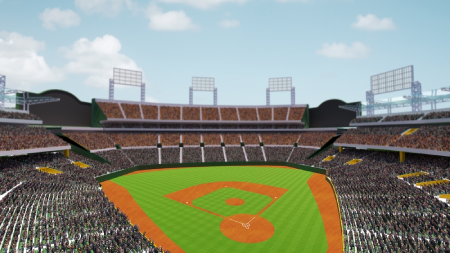A baseball field is more than just a place to play the game; it’s the heart of every baseball match. Whether you’re setting up your own field or simply learning about the layout, understanding the baseball field dimensions and components is crucial. In this guide, we’ll walk you through everything you need to know about a baseball field, from its layout to baseball fielder positions.

Content
Introduction to the Baseball Field
A baseball is divided into several key components, each playing a significant role in the game. From the baseball diamond to the outfield and the positioning of players, every element has a purpose. But to truly appreciate the game, understanding the baseball layout and the baseball field diagram is essential. Knowing where each element goes ensures the game flows seamlessly.
Baseball Diamond: The Central Piece of the Game
The baseball diamond is the iconic part of the baseball fielding. It consists of four bases arranged in a square shape, which is fundamental to the game. The layout of the diamond is designed to allow players to run, field, and strategize during the game.
The bases are set at a distance of 90 feet apart, forming a square, with the pitcher’s mound located in the center. Understanding the layout of this diamond in baseball is critical for both players and coaches to ensure that the field is properly constructed.
Key Components of the Baseball Field Layout
The baseball layout consists of two main areas: the infield and the outfield. The infield contains the bases and the pitcher’s mound, where most of the action occurs during a game. The outfield, on the other hand, stretches from the edge of the infield to the outfield fence, providing plenty of room for players to chase down hits.
Here’s a breakdown of the major components of the field:
- Infield: Comprising the diamond and the areas surrounding it.
- Outfield: The grass area beyond the diamond where fielders play to catch the ball.
- Pitcher’s Mound: Positioned at the center of the diamond, where the pitcher stands to throw the ball.
- Foul Lines: These lines mark the boundary of the field and separate fair territory from foul.
Each of these components must be built and laid out to specific dimensions to ensure a proper game environment.
Baseball Field Diagram: A Visual Representation
The baseball field diagram provides a clear visual of the layout, allowing you to see how everything fits together. This diagram includes the baseball bases, the pitcher’s mound, and the key sections of the diamond in baseball. It also highlights where the baseball fielder positions are usually located during a game. By referencing the baseball diagram, it’s easy to understand how the field is arranged and where each player should be.
Baseball Fielder Positions: Where Each Player Belongs
Proper positioning of players on the baseball field is key to both defense and strategy. There are nine positions on the field:
- Pitcher: Stands on the pitcher’s mound, throwing the ball to the batter.
- Catcher: Positioned behind home plate, ready to catch pitched balls and defend against runs.
- First Baseman: Covers first base and is responsible for catching throws from other infielders.
- Second Baseman: Positioned between first and second base, handling ground balls and turning double plays.
- Shortstop: Plays between second and third base, often handling the most difficult ground balls.
- Third Baseman: Covers third base and is usually positioned near the batter to handle fast ground balls.
- Left Fielder: Positioned in the outfield, ready to catch balls hit to the left side.
- Center Fielder: Positioned in the middle of the outfield, responsible for covering a large area.
- Right Fielder: Positioned in the outfield on the right side, working with the other outfielders.
Each of these positions plays a vital role in making the baseball Diamond a dynamic environment during the game.
Baseball Field Dimensions: Getting the Measurements Right

The baseball field dimensions are strictly defined by the rules of the game, and accuracy is key when setting up the field. The distance between the baseball bases is 90 feet, and the distance from the pitcher’s mound to home plate is 60 feet, 6 inches. These measurements ensure that the game is played fairly, with the correct balance of skill and athleticism.
- Pitcher’s Mound: 60 feet 6 inches from home plate.
- Base Distances: 90 feet between each base.
- Outfield Fence: Varies by field, but typically between 300 to 400 feet from home plate.
These measurements are non-negotiable, ensuring consistency across every baseball field.
The Importance of the Baseball Field Background
The baseball Diamond background can greatly impact the visibility of the game. A green, well-maintained field with proper lighting creates an optimal viewing environment for players and spectators alike. Additionally, the background can influence how a player tracks a pitched ball or a fly ball, making it an essential factor in game preparation.

Baseball Bases: The Cornerstones of the Game
The baseball bases are integral to the layout of the baseball diamond. As the player runs from base to base, the bases mark the path of progression towards a run. A proper understanding of the distance between these bases ensures that the players can time their runs and defensive moves accurately. Each base should be placed at the correct spot, as defined in the baseball Diamond dimensions.
Baseball Field Setup Tips: What You Need
Setting up a baseball Layout
requires careful attention to detail. Here are a few tips to ensure your field is built to the proper specifications:
- Measure the Bases Accurately: Ensure the distance between each base is exactly 90 feet.
- Position the Mound Correctly: The pitcher’s mound must be 60 feet, 6 inches from home plate.
- Maintain Proper Fielding Areas: The infield and outfield should be well-defined, with the outfield fence located within regulation distances.
- Use High-Quality Materials: Invest in durable materials for the baseball field background and the bases themselves to withstand heavy use.
Conclusion: Bringing the Baseball Field to Life
Creating and understanding a baseball field is more than just measuring dimensions. It’s about creating an environment where athletes can showcase their skills, and fans can experience the excitement of the game. Whether you’re building a field for recreational play or learning about baseball fielder positions, understanding the baseball field layout, baseball field diagram, and baseball bases is crucial. With proper attention to detail, your field can become the perfect setting for the great American pastime.
FAQ’s About Baseball Field Layout
1. What are the main components of a baseball field?
A baseball field consists of the diamond (bases and pitcher’s mound), the infield, outfield, and key markers like the foul lines, bases, and the pitcher’s rubber.
2. What is the distance between the bases on a baseball field?
In Major League Baseball, the distance between each base is 90 feet, forming a square shape known as the diamond.

Emily Harris is your ticket to the sports world. From thrilling competitions to heartwarming sportsmanship, she’s got you covered with her extensive sports insight.
